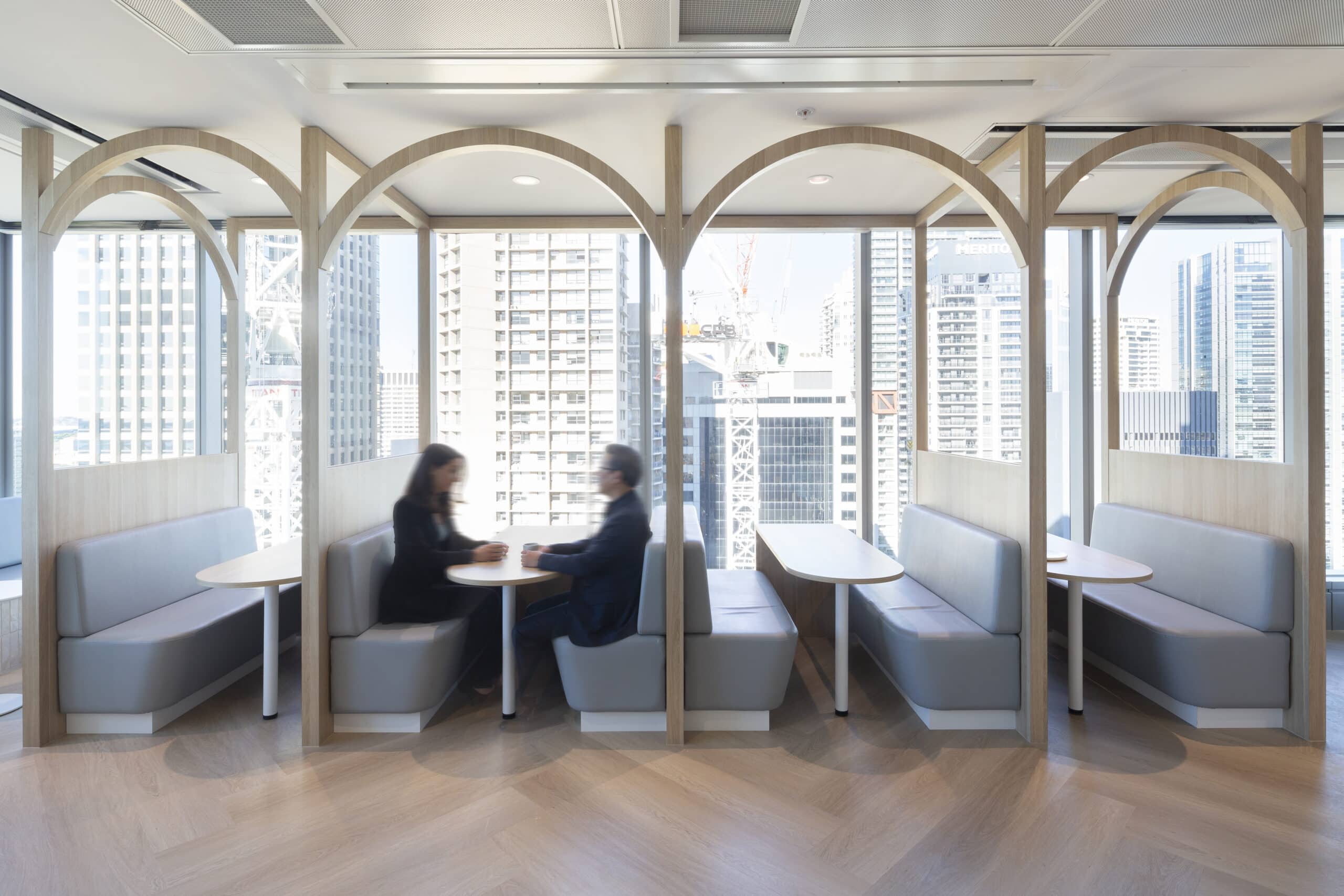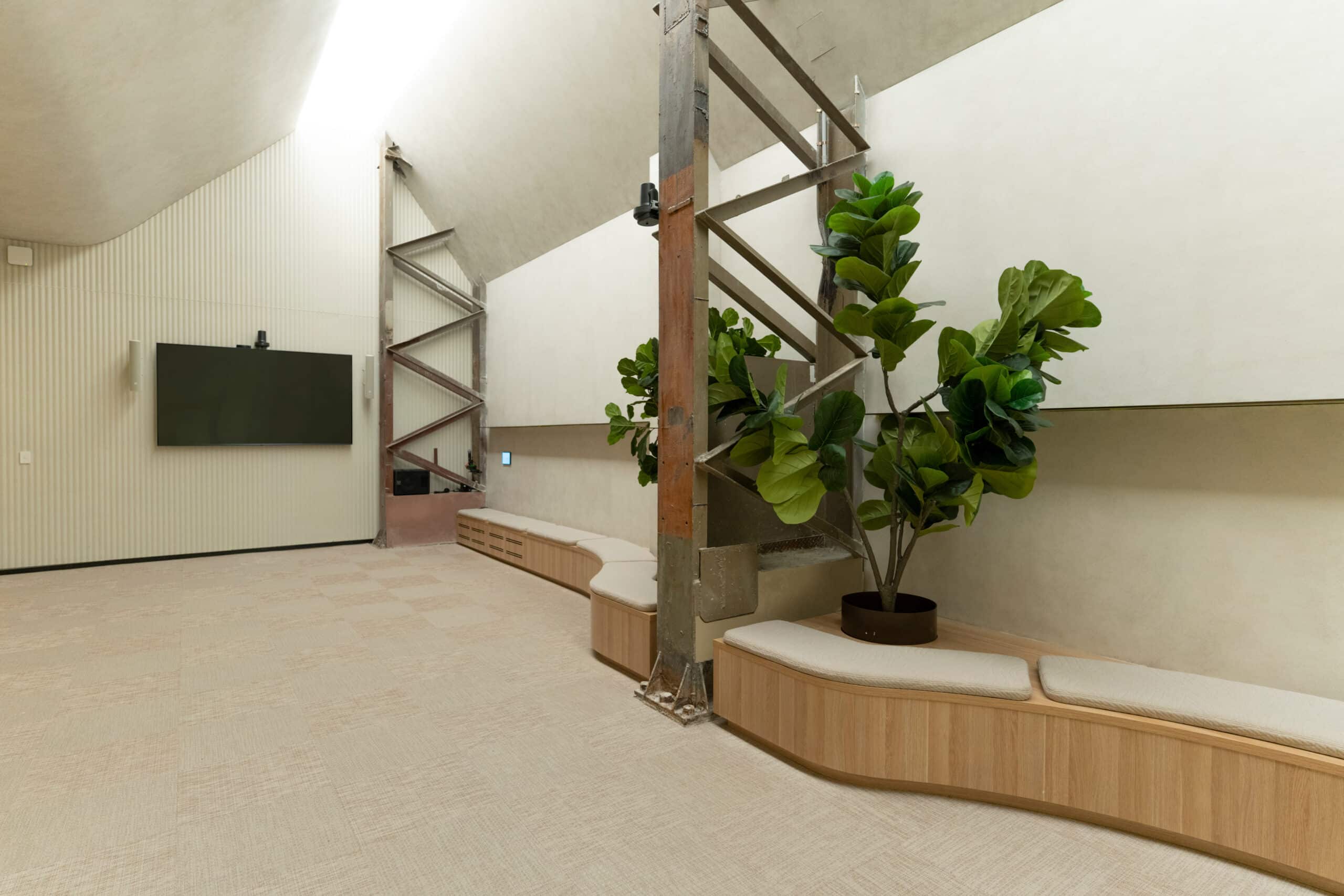
Creating a healthy workspace goes beyond providing employees with a safe, hazard-free space to work. The best workspaces are mindfully designed, both tangibly and operationally, to not only support employees’ physical and mental health, but to boost it.
An emphasis on wellness in the workplace has the power to impact an organisation, and its bottom line – with a reduction in absenteeism and improvement in overall employee physical and mental health, just the beginning.
Studies have shown that initiatives like 10 minutes of mindfulness each day can boost mental clarity and thus productivity, as well as actively lower stress levels, particularly in times of tight deadlines.
Dedication to employee wellness is no longer merely a ‘nice to have’ feature within an organisation. The power of balance has shifted to a more equal standing between employers and employees, with younger generations now demanding that employers transcend traditional approaches to employee wellbeing via innovative wellness programmes and initiatives – Source.
The importance of employee wellness programs
Many of today’s wellness initiatives, include (but are not limited to): financial wellness, parental wellness programs, workplace hyper-personalisation, conquering fatigue, and mindful working for mental health – Source.
Programs like these help to alleviate and/or better manage the debilitating symptoms of mental or physical health disorders. They can also encourage employees to eat healthier food, exercise more and manage stress more effectively. Essentially, by improving their overall wellbeing, wellness programs give employees the opportunity to operate as their best selves at work – Source.
Organisations that invest in these programmes are rewarded with a higher calibre of talent, higher employee engagement, increased output levels, and a reduction in turnover.
Employee wellness programs & workplace design
Organisations should never underestimate the ability of a workspace’s layout and design to enhance workplace wellness programs and overall employee wellbeing. In the past, workplace design focused mainly on providing only the necessary tools to bring out the best ‘work version’ of employees (ex. Tools, tasks and procedures). Today, we understand the importance of encouraging a more comprehensive state of wellbeing for employees at work – Source. Rather than constructing a workspace for people to fit into, organisations should switch their focus to designing the workspace around their people and the aspects of wellness that their people demand – Source. Thoughtful workplace design also encourages diversity, equity, and inclusivity (DE&I) within a company.
Let’s look at some of the most effective workplace design innovations that complement effective wellness programs and initiatives.
Design innovations to support a healthy work environment
Dedicated wellness spaces:
A designated space for employees to break away from the general noise and chaos of an office space, to decompress and rejuvenate on their own or with others. These spaces include anything from private breastfeeding rooms to prayer rooms, to sleeping pods, to exercise spaces.
A key feature in our recent project for Temple & Webster included a spacious wellness room, which provides a calm, safe space where members of the team can not only relax and recharge throughout the day, but also participate in daily yoga or meditation classes.

Biophilic design:
This is an architectural and design approach that integrates nature and natural elements into the built environment. It is rooted in the theory of ‘biophilia’, a term that describes the innate human affinity for the natural world – Source. Incorporating natural elements, such as plants, water, natural light, and natural materials within the workspace has been shown to boost productivity by 6%, creativity by 15% and general employee wellbeing by 15% – Source.
Biophilic design is more than adding a few plants around the office. It’s about appreciating the connection that humans have with the natural environment and going beyond to determine how someone can interact with all forms of nature throughout their working day – Source.
Personalised thermal comfort:
The ambient temperature of a workspace can change the way we think and work. Thermal comfort looks at optimising air temperature, radiant temperature, air velocity and humidity – Source.
What are some of the latest technologies being used to optimise thermal comfort in the workplace?
- Automated blinds or other window treatments that include built-in motors to remotely raise, lower or tilt based on a schedule, sensors, or on-demand – Source. These are being used to mitigate the intrusion of direct sunlight into workspace.
- Thanks to automation, sensors and interconnection, smart HVAC solutions can monitor the air quality and temperature of the workplace. This not only creates a more comfortable work environment, but it also helps to reduce an organisation’s carbon footprint – Source.
- For even more personalised temperature control, ergonomic chairs with in-built heating and cooling (and even massage) systems are now available – Source.
Circadian lighting:
Research by Cornell University Professor Dr. Alan Hedge reinforces the connection between natural light and employee wellbeing. It was discovered that workers within naturally lit office environments reported a 51% drop in the incidence of eyestrain, a 63% drop in the incidence of headaches and a 56% reduction in drowsiness – Source.
A recent trend in workspace lighting technology to aid in the presence of natural light is the use of circadian lighting systems. The circadian rhythm is the body’s 24-hour mechanism that impacts the behavioural, biological, and mental processes (i.e., Productivity, alertness, body temperature, sleep cycle, and even the digestive system) – Source. Circadian lighting systems are designed to sync with the human circadian system by replicating the presence of natural light from daytime to night time – Source. As a result, these systems are proven to positively affect employee’s health, alertness, productivity, and more.
Flexible spaces:
Flexible spaces and modular design allow employees to work wherever and however they work best. The workplace should incorporate a variety of spaces to support the many ways in which people work. i.e., private spaces for focused work and collaboration spaces for group ideation and teamwork. Some innovative elements being used to create flexible/modular spaces may include:
- Tech-integrated furniture (i.e., built in charging ports, wireless charging pads, and USB hubs) and multifunctional pieces (modular desks and mobile furniture) allows for movement, as well as less restrictive furniture placement (ex. Proximity to wall outlets) – Source.
- Soft upholstery work areas and home-like spaces, such as an office kitchen or restaurant, give employees the option to venture away from their traditional desk area. They are designed to assist in the rapidly changing needs of the workplace as we migrate away from personal desks towards shared, collaborative spaces and furniture – Source.
- Personal or multi-person pods allow employees to take phone calls, video conversations, zone in on highly focused work, and have 1-on-1 or small group meetings – Source.
- Smart glass can be used as doors, walls, or windows within the office space. These can go from clear to frosted on demand, providing instant privacy when needed – Source.
- Operable walls can easily be reconfigured to generate different layouts and accommodate various functions, such as private offices, meeting rooms, or collaborative spaces – Source.
Noise and acoustics:
Ambient noise can increase general stress levels and aggravate stress-related conditions, such as high blood pressure, coronary disease, peptic ulcers and migraine headaches – Source. Creating quiet areas with increased acoustic dissolution (such as fabric workspace dividers) or areas with white noise machines can reduce this distraction – Source.
Air quality and ventilation:
The COVID-19 pandemic amplified public awareness about how indoor environmental quality (IEQ) can affect human health and wellbeing and workers are more concerned than ever about indoor air quality and ventilation – Source. Prioritising IEQ in the workplace provides ~20% productivity gains due to improved cognitive functions and fewer sick days. Aside from continual air quality monitoring, living walls and the incorporation of living plants into workplace design (i.e., Biophilic design) can aid in this process, as plants are proven to purify the air and rid it of carbon dioxide and other toxins.
Anti-microbial surfaces:
The pandemic also highlighted the role that surfaces play in the spread of disease and other illnesses. As a result, scientists around the world are developing ‘smart surfaces’ or ‘anti-microbial surfaces’, which are now being used to cut down on the spread of viral and bacterial diseases. These materials are designed to make it harder for microbes to attach, and if they do become established, the surfaces are engineered to either kill them outright, or make it far easier to rinse them off – Source.
Conclusion
It’s crucial that workspaces are designed to help employees bring their best, well-rounded selves to work. At Spaceful, we prioritise configuring workspaces around your organisation’s people, rather than expecting them to fit into a pre-existing mould. We bring a fresh vision into how each unique workspace is designed, created, and used and we empower people to do their best work by creating the workspaces that boost employee wellbeing, and therefore, operational performance.


